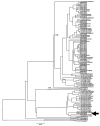Hepatitis B virus infection in post-vaccination South Africa: occult HBV infection and circulating surface gene variants
- PMID: 25600597
- PMCID: PMC4560343
- DOI: 10.1016/j.jcv.2014.11.032
Hepatitis B virus infection in post-vaccination South Africa: occult HBV infection and circulating surface gene variants
Abstract
Background and objective: The aim of this study was to investigate the prevalence of occult hepatitis B virus (HBV) infection and the HBV surface (S) gene variants circulating in the South African population after nearly two decades of universal hepatitis B vaccination.
Study design: From a previous serosurvey, 201 serum samples with serological evidence of exposure to HBV were identified and these were stratified into post- and pre-vaccine introduction populations. For all samples, HBV DNA was screened and quantified using a real-time PCR assay and results analysed together with HBV serological markers. Where HIV results were available, subset analysis was performed. The HBV S gene was PCR-amplified and sequences analysed for a total of 37 isolates.
Results: The prevalence of occult HBV infection reduced from 70.4% in the pre-vaccine introduction era to 66.0% post-vaccine introduction. There was an association between HIV infection and an increase in prevalence of occult HBV infection within the post-vaccine introduction population, although this was not statistically significant. Furthermore, sequence analysis revealed the following HBV subgenotypes; A1 (n=34), A2 (n=2) and a rare D4 isolate. HBV S gene variants, including diagnostic escape mutants were isolated.
Conclusion: There was a decline in the prevalence of occult HBV infection in post-vaccination South Africa, although the disease burden remains significant in the HIV co-infected population. After nearly two decades of a universal hepatitis B vaccination programme, no positive selection of vaccine escape mutants were observed.
Keywords: Diagnostic escape mutants; HIV infection; Hepatitis B vaccine; Occult HBV infection; Subgenotype D4.
Copyright © 2014 Elsevier B.V. All rights reserved.
Figures
References
-
- Alavian SM, Carman WF, Jazayeri SM. HBsAg variants: diagnostic escape and diagnostic dilemma. J Clin Virol. 2012;57:201–8. - PubMed
-
- Amponsah-Dacosta E, Lebelo RL, Rakgole JN, Burnett RJ, Selabe SG, Mphahlele MJ. Evidence for a change in the epidemiology of hepatitis B virus infection after nearly two decades of universal hepatitis B vaccination in South Africa. J Med Virol. 2014;86:918–24. - PubMed
-
- Ayuk J, Mphahlele J, Bessong P. Hepatitis B virus in HIV-infected patients in north-eastern South Africa: prevalence, exposure, protection and response to HAART. S Afr Med J. 2013;103:330–3. - PubMed
-
- Barth RE, Huijgen Q, Templeman HA, Mudrikova T, Wensing AMJ, Hoepelman AIM. Presence of occult HBV, but near absence of active HBV and HCV infections in people with HIV infection in rural South Africa. J Med Virol. 2011;83:929–34. - PubMed
-
- Bell TG, Makondo E, Martinson NA, Kramvis A. Hepatitis B virus infection in human immunodeficiency virus infected Southern African Adults: occult or overt – that is the question. PLoS ONE. 2012;7:e45750. http://dx.doi.org/10.1371/journal.pone.0045750. - DOI - PMC - PubMed
Publication types
MeSH terms
Substances
Grants and funding
LinkOut - more resources
Full Text Sources
Other Literature Sources
Medical


